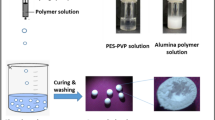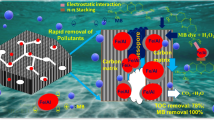Abstract
Newly few-layered boron nitride (BN-550) nanosheets were developed by a low-temperature synthesis method, which was used to rapidly and efficiently adsorb lead ions (Pb2+). The samples were characterized by using XRD, FT-IR, EELS, SEM, TEM, AFM and XPS, revealing that it possessed the large specific surface area (696 m2 g−1), ultrathin sheet structure (1.2 nm thickness), and abundant chemical bonds as multiple adsorption sites. The adsorption properties showed that higher adsorption capacity (845 mg g−1) for lead ions and less equilibrium time (15 min) than many adsorbents reported at present. The adsorption kinetics and isotherms of BN-550 belonged to the pseudo-second-order model and Langmuir model, respectively. The easy recyclability and stability of BN-550 were verified by the experiments regeneration and pH. Interference experiments indicated that the adsorbents were strong affinity for Pb2+ under the interference of other heavy metal ions such as Ni2+, Cu2+, and Cd2+ ions (their adsorbing capacity individually are 201, 402, and 312 mg g−1). The XPS and FT-IR analysis revealed that the excellent adsorption performances for Pb2+ attributed to the chemical binding reactions with the numerous surface functional groups, such as the strong B–O–Pb interactions and –NH2···Pb complex. The threshold value of Pb2+ removal on BN-550 nanosheets was 1080 mL g−1 when Pb2+ concentration was 50 mg L−1 in adsorption column. The unique characteristics render ultrathin nanosheets highly promising as an ideal candidate for the removal of lead ions.









Similar content being viewed by others
References
Chen S, Chen D, Wang W, Quan H, Luo X, Guo L (2017) rGO-stabilized MnO/N-doped carbon nanofibers for efficient removal of Pb(II) ion and catalytic degradation of methylene blue. J Mater Sci 52:5117–5132. https://doi.org/10.1007/s10853-017-0749-7
Meng J, Cui J, Yu J et al (2017) Preparation of green chelating fibers and adsorption properties for Cd(II) in aqueous solution. J Mater Sci 53:2277–2289. https://doi.org/10.1007/s10853-017-1653-x
Ribeiro C, Scheufele FB, Espinoza-Quiñones FR et al (2018) A comprehensive evaluation of heavy metals removal from battery industry wastewaters by applying bio-residue, mineral and commercial adsorbent materials. J Mater Sci 53:7976–7995. https://doi.org/10.1007/s10853-018-2150-6
Ali J, Wang H, Ifthikar J et al (2018) Efficient, stable and selective adsorption of heavy metals by thio-functionalized layered double hydroxide in diverse types of water. Chem Eng J 332:387–397
Qi X, Xie F (2018) Promotion effects of potassium permanganate on removal of Pb(II), Ni(II) and Cd(II) from hydrous manganese dioxide. Chem Eng J 351:22–30
Gao Q, Wang CZ, Liu S, Hanigan D, Liu ST, Zhao HZ (2019) Ultrafiltration membrane microreactor (MMR) for simultaneous removal of nitrate and phosphate from water. Chem Eng J 355:238–246
Efome JE, Rana D, Matsuura T, Lan CQ (2018) Experiment and modeling for flux and permeate concentration of heavy metal ion in adsorptive membrane filtration using a metal–organic framework incorporated nanofibrous membrane. Chem Eng J 352:737–744
Johansson S, Ruscalleda M, Colprim J (2017) Phosphorus recovery through biologically induced precipitation by partial nitritation–anammox granular biomass. Chem Eng J 327:881–888
Wang X, Jing S, Hou Z et al (2018) Permeable, robust and magnetic hydrogel beads: water droplet templating synthesis and utilization for heavy metal ions removal. J Mater Sci 53:15009–15024. https://doi.org/10.1007/s10853-018-2681-x
Kolodynska D, Krukowska J, Thomas P (2017) Comparison of sorption and desorption studies of heavy metal ions from biochar and commercial active carbon. Chem Eng J 307:353–363
Najafi M, Rostamian R, Rafati AA (2011) Chemically modified silica gel with thiol group as an adsorbent for retention of some toxic soft metal ions from water and industrial effluent. Chem Eng J 168:426–432
Qiu W, Zheng Y (2009) Removal of lead, copper, nickel, cobalt, and zinc from water by a cancrinite-type zeolite synthesized from fly ash. Chem Eng J 145:483–488
Wang H, Wang W, Wang H, Zhang F, Li Y, Fu Z (2018) Urchin-like boron nitride hierarchical structure assembled by nanotubes-nanosheets for effective removal of heavy metal ions. Ceram Int 44:12216–12224
Liu Z, Fang Y, Jia H et al (2018) Novel multifunctional cheese-like 3D carbon-BN as a highly efficient adsorbent for water purification. Sci Rep 8:1104. https://doi.org/10.1038/s41598-018-19541-5
Chen MM, Wei D, Chu W, Wang T, Tong DG (2017) One-pot synthesis of O-doped BN nanosheets as capacitive deionization electrode for efficient removal of heavy metal ions from water. J Mater Chem A 5:17029–17039
Zhang X, Lian G, Zhang SJ, Cui DL, Wang QL (2012) Boron nitride nanocarpets: controllable synthesis and their adsorption performance to organic pollutants. CrystEngComm 14:4670–4676
Lee C, Li QY, Kalb W et al (2010) Frictional characteristics of atomically thin sheets. Science 328:76–80
Nag A, Raidongia K, Hembram K, Datta R, Waghmare UV, Rao CNR (2010) Graphene analogues of BN: novel synthesis and properties. ACS Nano 4:1539–1544
Li J, Xiao X, Xu XW et al (2013) Activated boron nitride as an effective adsorbent for metal ions and organic pollutants. Sci Rep 3:3208. https://doi.org/10.1038/srep03208
Li J, Jin P, Dai W et al (2017) Excellent performance for water purification achieved by activated porous boron nitride nanosheets. Mater Chem Phys 196:186–193
Lei W, Portehault D, Liu D, Qin S, Chen Y (2013) Porous boron nitride nanosheets for effective water cleaning. Nat Commun 4:1777
Yu S, Wang X, Pang H et al (2017) Boron nitride-based materials for the removal of pollutants from aqueous solutions: a review. Chem Eng J 333:343–360
Manawi Y, McKay G, Ismail N, Kayvani Fard A, Kochkodan V, Atieh MA (2018) Enhancing lead removal from water by complex-assisted filtration with acacia gum. Chem Eng J 352:828–836
Zhang Z, Wang X, Wang H, Zhao J (2018) Removal of Pb(II) from aqueous solution using hydroxyapatite/calcium silicate hydrate (HAP/C-S-H) composite adsorbent prepared by a phosphate recovery process. Chem Eng J 344:53–61
He J, Cai X, Chen K et al (2016) Performance of a novelly-defined zirconium metal–organic frameworks adsorption membrane in fluoride removal. J Colloid Interface Sci 484:162–172
Hayati B, Maleki A, Najafi F et al (2018) Heavy metal adsorption using PAMAM/CNT nanocomposite from aqueous solution in batch and continuous fixed bed systems. Chem Eng J 346:258–270
Xiong J, Zhu W, Li H et al (2015) Carbon-doped porous boron nitride: metal-free adsorbents for sulfur removal from fuels. J Mater Chem A 3:12738–12747
Weng QH, Wang XB, Zhi CY, Bando Y, Golberg D (2013) Boron nitride porous microbe its for hydrogen storage. ACS Nano 7:1558–1565
Zhi CY, Bando Y, Tan CC, Golberg D (2005) Effective precursor for high yield synthesis of pure BN nanotubes. Solid State Commun 135:67–70
Iyyamperumal E, Wang SY, Dai LM (2012) Vertically aligned BCN nanotubes with high capacitance. ACS Nano 6:5259–5265
McCann R, Roy SS, Papakonstantinou P et al (2005) NEXAFS study and electrical properties of nitrogen-incorporated tetrahedral amorphous carbon films. Diam Relat Mater 14:1057–1061
Pang J, Chao Y, Chang H et al (2017) Tuning electronic properties of boron nitride nanoplate via doping carbon for enhanced adsorptive performance. J Colloid Interface Sci 508:121–128
Wang J, Hao J, Liu D et al (2017) Flower stamen-like porous boron carbon nitride nanoscrolls for water cleaning. Nanoscale 9:9787–9791
Jiang LY, Ye QC, Chen JM, Chen Z, Gu YL (2018) Preparation of magnetically recoverable bentonite–Fe3O4–MnO2 composite particles for Cd(II) removal from aqueous solutions. J Colloid Interface Sci 513:748–759
Li Y, Zhao R, Chao S, Sun B, Wang C, Li X (2018) Polydopamine coating assisted synthesis of MnO2 loaded inorganic/organic composite electrospun fiber adsorbent for efficient removal of Pb2+ from water. Chem Eng J 344:277–289
Jia J, Liu C, Wang L, Liang X, Chai X (2018) Double functional polymer brush-grafted cotton fiber for the fast visual detection and efficient adsorption of cadmium ions. Chem Eng J 347:631–639
Bouabidi ZB, El-Naas MH, Cortes D, McKay G (2018) Steel-making dust as a potential adsorbent for the removal of lead (II) from an aqueous solution. Chem Eng J 334:837–844
Fei L, Jie Y, Xixi J, Muqi Q (2015) Nanosheet-structured boron nitride spheres with a versatile adsorption capacity for water cleaning. ACS Appl Mater Interfaces 7:1824–1832
Wang Y, Chen NP, Wei W, Cui J, Wei ZG (2011) Enhanced adsorption of fluoride from aqueous solution onto nanosized hydroxyapatite by low-molecular-weight organic acids. Desalination 276:161–168
Zhang D, Luo H, Zheng L et al (2012) Utilization of waste phosphogypsum to prepare hydroxyapatite nanoparticles and its application towards removal of fluoride from aqueous solution. J Hazard Mater 241–242:418–426
Huang Q, Chen Y, Yu H et al (2018) Magnetic graphene oxide/MgAl-layered double hydroxide nanocomposite: one-pot solvothermal synthesis, adsorption performance and mechanisms for Pb2+, Cd2+, and Cu2+. Chem Eng J 341:1–9
Chen K, He J, Li Y et al (2017) Removal of cadmium and lead ions from water by sulfonated magnetic nanoparticle adsorbents. J Colloid Interface Sci 494:307–316
Wu S, Zhang K, Wang X et al (2015) Enhanced adsorption of cadmium ions by 3D sulfonated reduced graphene oxide. Chem Eng J 262:1292–1302
He J, Li Y, Wang C et al (2017) Rapid adsorption of Pb, Cu and Cd from aqueous solutions by β-cyclodextrin polymers. Appl Surf Sci 426:29–39
Zhao J, Niu Y, Ren B et al (2018) Synthesis of Schiff base functionalized superparamagnetic Fe3O4 composites for effective removal of Pb(II) and Cd(II) from aqueous solution. Chem Eng J 347:574–584
Qin F, Wen B, Shan XQ et al (2006) Mechanisms of competitive adsorption of Pb, Cu, and Cd on peat. Environ Pollut 144:669–680
Ducoroy L, Bacquet M, Martel B, Morcellet M (2008) Removal of heavy metals from aqueous media by cation exchange nonwoven PET coated with β-cyclodextrin-polycarboxylic moieties. React Funct Polym 68:594–600
Li J, Tong JJ, Li XH, Yang ZJ, Zhang YC, Diao GW (2016) Facile microfluidic synthesis of copolymer hydrogel beads for the removal of heavy metal ions. J Mater Sci 51:10375–10385. https://doi.org/10.1007/s10853-016-0258-0
Wang N, Xu X, Li H et al (2016) Preparation and application of a xanthate-modified thiourea chitosan sponge for the removal of Pb(II) from aqueous solutions. Ind Eng Chem Res 55:4960–4968
Zhu Y, Hu J, Wang J (2012) Competitive adsorption of Pb(II), Cu(II) and Zn(II) onto xanthate-modified magnetic chitosan. J Hazard Mater 221:155–161
Ling LL, Liu WJ, Zhang S, Jiang H (2017) Magnesium oxide embedded nitrogen self-doped biochar composites: fast and high-efficiency adsorption of heavy metals in an aqueous solution. Environ Sci Technol 51:10081–10089
World Health Organization (2011) Guidelines for drinking-water quality, 4th edn. World Health Organization
Acknowledgements
This work was supported by the Natural Science Foundation of China (21277146), the Key Technologies R & D Program Foundation of Anhui Province (1704a0802136), the Chinese academy of sciences key deployment project (KFZD-SW-309), the CASHIPS Director’s Fund (YZJJ201701) and the Young Spark Project Foundation of CASHIPS (YZJJ201617).
Author information
Authors and Affiliations
Corresponding authors
Electronic supplementary material
Below is the link to the electronic supplementary material.
Rights and permissions
About this article
Cite this article
Liu, T., Li, Y., He, J. et al. Few-layered boron nitride nanosheets as superior adsorbents for the rapid removal of lead ions from water. J Mater Sci 54, 5366–5380 (2019). https://doi.org/10.1007/s10853-018-03240-7
Received:
Accepted:
Published:
Issue Date:
DOI: https://doi.org/10.1007/s10853-018-03240-7




